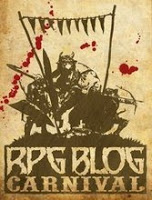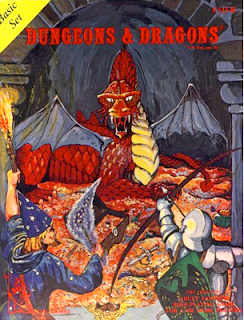This month’s RPG Blog Carnival is on the subject of how to teach new gamers to play. I thought I’d focus on the utility of so-called “quick start” rules.
When you have a large and complex game such as D&D, it cannot help but be overwhelming to a new player. Even the best designed rules are going to intimidate by sheer length, and RPGs are famed for not maximizing their organizational potential, shall we say?
One route that some companies go for is to produce a sub-set of the total rules set, offering that as a basic version of the full game. TSR naturally started this practice way back with the introduction of the “red dragon box”, which for many was the gateway drug to AD&D. More recently, HackMaster has introduced its fifth edition with HackMaster Basic, and many other companies have taken to the idea, including of course WotC with their upcoming D&D Essentials boxed set.
The question becomes, what gets cut out to create a basic rules set?
Usually rules relating to higher-level characters are gone (in those games that are class and level based, of course). I personally don’t have a problem with that, as long as it’s not a ridiculously truncated limit. I should be able to get a feel for the game as a whole, and usually that can’t be done by just puttering around as a 2nd level nebbish.
Monsters and other creatures usually get trimmed severely. Again, no problem, as long as some of the “core” creatures are not excised; I can’t imagine a D&D without orcs, for instance. Norkers, sure.
Class options. Especially in the case of a game like AD&D, which has not only classes but sub-classes, it’s possible to trim some of the clutter. A basic game can get along with only clerics, fighters, magic-users, and thieves. Save druids, rangers, and assassins for the advanced, full-blown game.
When it comes to rules, it’s a tricky proposition. How much can you trim from the combat system, for instance, before it turns into something new, rather than a stripped-down version of the full system? On the other hand, a basic rules set demands a certain brevity that, by extension, creates ambiguity. Do your basic rules contain as full a discussion of invisibility and its consequences as your complete rules? Probably not, which means that a GM running the basic game might come up with an on-the-fly ruling at variance with how the same situation would be treated in the full game. Such is the nature of the beast.
On the whole, I think these basic sets are a good way to introduce new players to a particular game, without overwhelming them with detail that isn’t necessary for them to get a feel for how the full game plays, and ahve fun while doing so. It’s certainly not a requirement, as there are plenty of “full games” that aren’t nearly so complex as to require such a basic rules set. But for the big’uns, I think it’s a very good strategy.











The basic set (which you have pictured) was my introduction to D&D in 1978… but, as I recall, I didn't really sit down a read the rules through until after I had been playing a while. The default method of learning to play(at least in our circle)was to just sit down and start playing — another player or the DM would help you roll up a character (as I recall, buying your stuff and thinking up a name were the hardest parts of that) and then you would be tossed into the group where you would learn the rules as you went along.
Since it wasn't a game with winners and losers, not knowing the rules was less of a hinderance than it would be in a conventional board game… and at that time (in our group, at least)it seemed like most of the rules were made up on the spot or by DM fiat, anyway. The new player would know that he could do most of the things he could imagine himself doing (I say "he" because we were all boys).
I'm sure everyone has, at some stage or another, had to/tried to/wanted to introduce someone completely new to AD&D, or even paper RPGs overall. I've done it with WFRP, I've done it with AD&D (and 2nd), a good DM helps immensely and an experienced DM can introduce people that are entirely new to a game without the aid of a basic set of rules with only a little extra effort.
The value of such basic sets is, to me, the ability to really boil down the FEEL as well as some of the major points of rules for a completely new player to be able to take them home (on the cheap, preferably), and be able to start learning the art of the DM, be able to jump into a campaign with perhaps more experienced players and most importantly be convinced that the game will be fun and worth investing in the whole way.
To simplify the layout of rules goes a long way to that, but to truly express the main concepts and overall sense of actually playing the "full" game in a starter set is an entirely more difficult proposition.
The best way to introduce people to the hobby is through play. No special materials needed.
That, however, isn’t always an option. When I bought my Basic Set, I didn’t know anyone who played. You may have a nephew/niece or other relative who might enjoy the hobby but who doesn’t live close enough to mentor directly.
This is where an introductory set is needed. In general, I don’t think an introductory set needs to simplify the game. (But then, I have a preference for simple systems.) Rather, it needs to teach the game. The whole game.
Teaching the game is a completely different function than the main rules, which should be designed for reference. Also, the main rules should be complete and playtested before thought is ever given to the introductory rules. You want to teach a robust and finished system—not one in progress.
I have mixed feelings about the “choose your own adventure” style of tutorial. In a couple of cases, I’ve found such solitaire adventures useful in learning a new system. On the other hand, I’ve played a lot of bad solitaire adventures. I also think that solitaire adventures designed to introduce the hobby don’t really give a good feel for the hobby. An example of play, I think, goes a lot further in helping a new player understand the hobby.
And the example of play ought to demonstrate the players doing everything except what the GM expects them to. ^_^
But then, what do I know? Just my observations.
P.S. So far, I’m fairly impressed by the LotFP Weird RPG in this regard.
I learned to play from the Holmes edition D&D. I also didn't know anyone who played at the time. Once I read it through and figured it out I persuaded a friend to play. I then moved on to AD&D. If I would've tried to read the AD&D stuff first I don't think I would've ever played. So I'm a big supporter of introductory/basic sets.
The best quick-start I've seen is the Call of Cthulhu one, but it could be considered cheating, as the full rules are only about fifteen pages long!